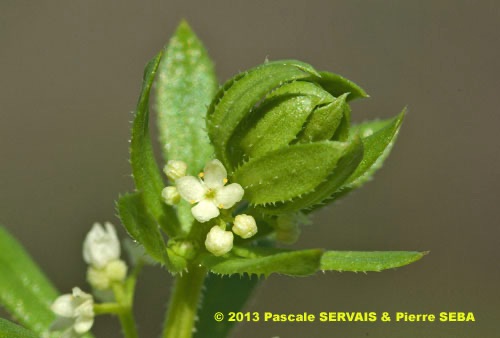
Galium verrucosum Huds.
Fam. : Rubiaceae
© Pascale SERVAIS & Pierre SEBA, 2018. Tilo Botanica: Flore de Tilos et du Dodécanèse / Flora of Tilos and of the Dodecanese
English translation by Brenda Bradbury, Howard Bradbury and Stéphane Léonard
Plante herbacée, hermaphrodite, à tiges étalées à érigées, ramifiées, quadrangulaires, pourvues sur les angles de poils crochus renversés, ce qui leur permet de s’accrocher aux autres plantes.
Feuilles verticillées par 5 ou 6, simples, linéaires ou lancéolées, très étroites, de 6 à 12 mm de long et de 2,5 à 5 mm de large, entières, à faces glabres, mais à bords ciliés rudes (cils dirigés vers le sommet de la feuille). Stipules semblables aux feuilles.
Fleurs à symétrie radiaire, blanchâtres, de 1 à 2,5 mm de diamètre, réunies par 1 à 3 en cymes bipares de 3 à 5 mm de large, plus courtes que les feuilles sous-jacentes. Seule la fleur centrale de la cyme est fertile. Corolle à 4 pétales (parfois 3) soudés à la base. Ovaire infère.
Fruits, capsules sphériques, de 2 à 3 mm de diamètre, vert pâle, glabres, verruqueuses, portées par des pédicelles recourbés.
___________________________
Plant herbaceous, hermaphrodite. Stems spread out to erect, branched, quadrangular, provided on the angles with resupinate hooked hairs, which enables them to cling to the other plants.
Leaves whorled by 5 or 6, simple, linear or lanceolate, very narrow, from 6 to 12 mm long and from 2.5 to 5 mm across, entire, with glabrous faces, but with hard ciliate edges (fine hairs directed towards the top of the leaf). Stipules similar to the leaves.
Flowers radially symmetrical, whitish, from 1 to 2.5 mm in diameter, joined together by 1 to 3 in dichasial cymes from 3 to 5 mm across, shorter than the underlying leaves. Only the central flower of the cyme is fertile. Corolla with 4 partly fused petals (sometimes 3). Ovary inferior.
Fruits, spherical capsules, from 2 to 3 mm in diameter, pale green, glabrous, verrucose, carried by recurved pedicels.
Descripteurs / Identifying features
1
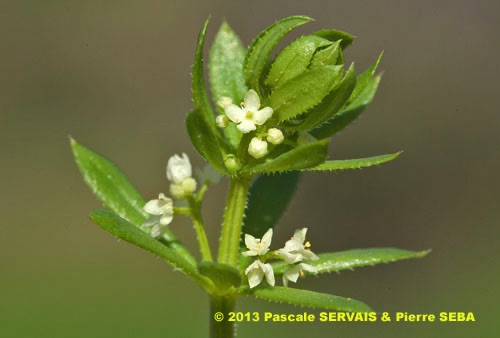
2
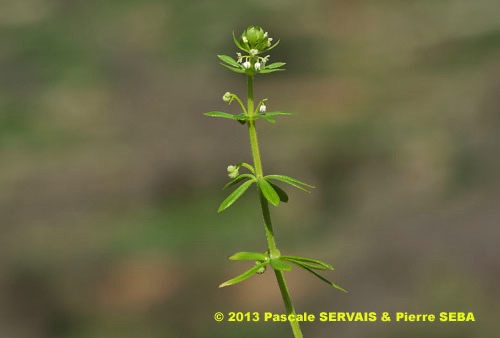
3
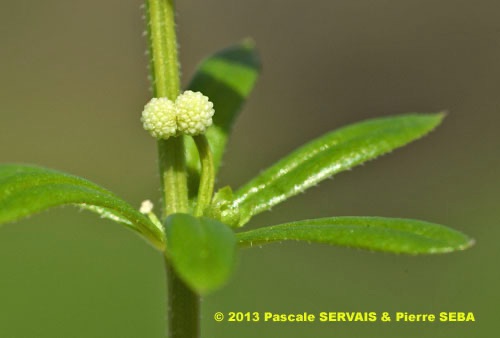
4
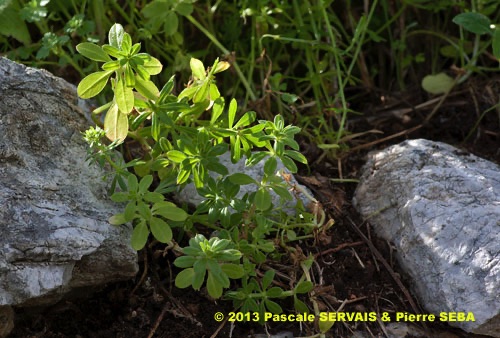
5
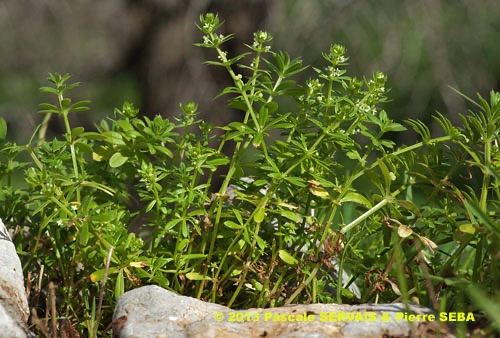
6
Étymologie / Etymology :
Galium : emprunt du grec ancien γάλα, γάλακτος (nom) = le lait,
en référence à la propriété de certaines espèces utilisées pour faire
cailler le lait.
Verrucosum : emprunt du latin verrucosus, -a, -um (adj.)
[ < verruca, -ae (nom) = l’excroissance, la verrue ] = couvert de
verrues, verruqueux, en référence aux fruits verruqueux.
Galium : borrowed from Classical Greek γάλα, γάλακτος (noun) = milk,
referring to the property of some species used to curdle milk.
Verrucosum : borrowed from Latin verrucosus, -a, -um (adj)
[ < verruca, -ae (noun) = outgrowth, wart ] = covered in warts, warty,
referring to the warty fruits.
Synonymes / Synonyms :
Aparine verrucosa Moench
Galium saccharatum All.
Galium valantia Weber
Valantia aparine L.
Valantia saccharata Poir.
Valantia triflora Lam.
Noms vernaculaires / Common names :
Noms français / French names :
Gaillet à verrues — Gaillet anisé — Gaillet verruqueux.
Noms anglais / English names :
Southern cleavers — Warty bedstraw.
Nom allemand / German name :
Anis-Labkraut.
Nom espagnol / Spanish name :
Hierba confitera.
Nom italien / Italian name :
Caglio verrucoso.
Habitat :
Cultures - Lieux incultes - Chemins - Murs, rochers.
Cultivated places - Waste ground - Waysides - Walls, rocks.
Île / Island :
Tilos.
Hauteur / Height range :
De 10 cm à 30 cm.
From 10 cm to 30 cm.
Floraison / Flowering time :
De janvier à mai.
From January to May.
Groupe / Classification :
Dicotylédones.
Dicotyledons.
Pérennité / Lifespan :
Annuelle.
Annual.
Description :
Clés dichotomiques et descripteurs distinctifs des 8 espèces / Dichotomous keys and distinctive identifying features of the 8 species
Photo 1 :
Localisation / Location : Tilos, Megalochorio, Environs
Date : 25/01/2013
GPS : Lat. 36,45098° N / Long. 27,34045° E / Alt. 24 m
Type : Photographie numérique / Digital Photograph (10 mégapixels)
Photo 2 :
Localisation / Location : Tilos, Megalochorio, Environs
Date : 25/01/2013
GPS : Lat. 36,45098° N / Long. 27,34045° E / Alt. 24 m
Type : Photographie numérique / Digital Photograph (10 mégapixels)
Photo 3 :
Localisation / Location : Tilos, Megalochorio, Environs
Date : 25/01/2013
GPS : Lat. 36,45098° N / Long. 27,34045° E / Alt. 24 m
Type : Photographie numérique / Digital Photograph (10 mégapixels)
Photo 4 :
Localisation / Location : Tilos, Megalochorio, Environs
Date : 25/01/2013
GPS : Lat. 36,45098° N / Long. 27,34045° E / Alt. 24 m
Type : Photographie numérique / Digital Photograph (10 mégapixels)
Photo 5 :
Localisation / Location : Tilos, Megalochorio, Environs
Date : 25/01/2013
GPS : Lat. 36,45098° N / Long. 27,34045° E / Alt. 24 m
Type : Photographie numérique / Digital Photograph (10 mégapixels)
Photo 6 :
Localisation / Location : Tilos, Megalochorio, Environs
Date : 25/01/2013
GPS : Lat. 36,45098° N / Long. 27,34045° E / Alt. 24 m
Type : Photographie numérique / Digital Photograph (10 mégapixels)

Google Maps
Google Maps
Google Maps
Google Maps
Google Maps
Google Maps